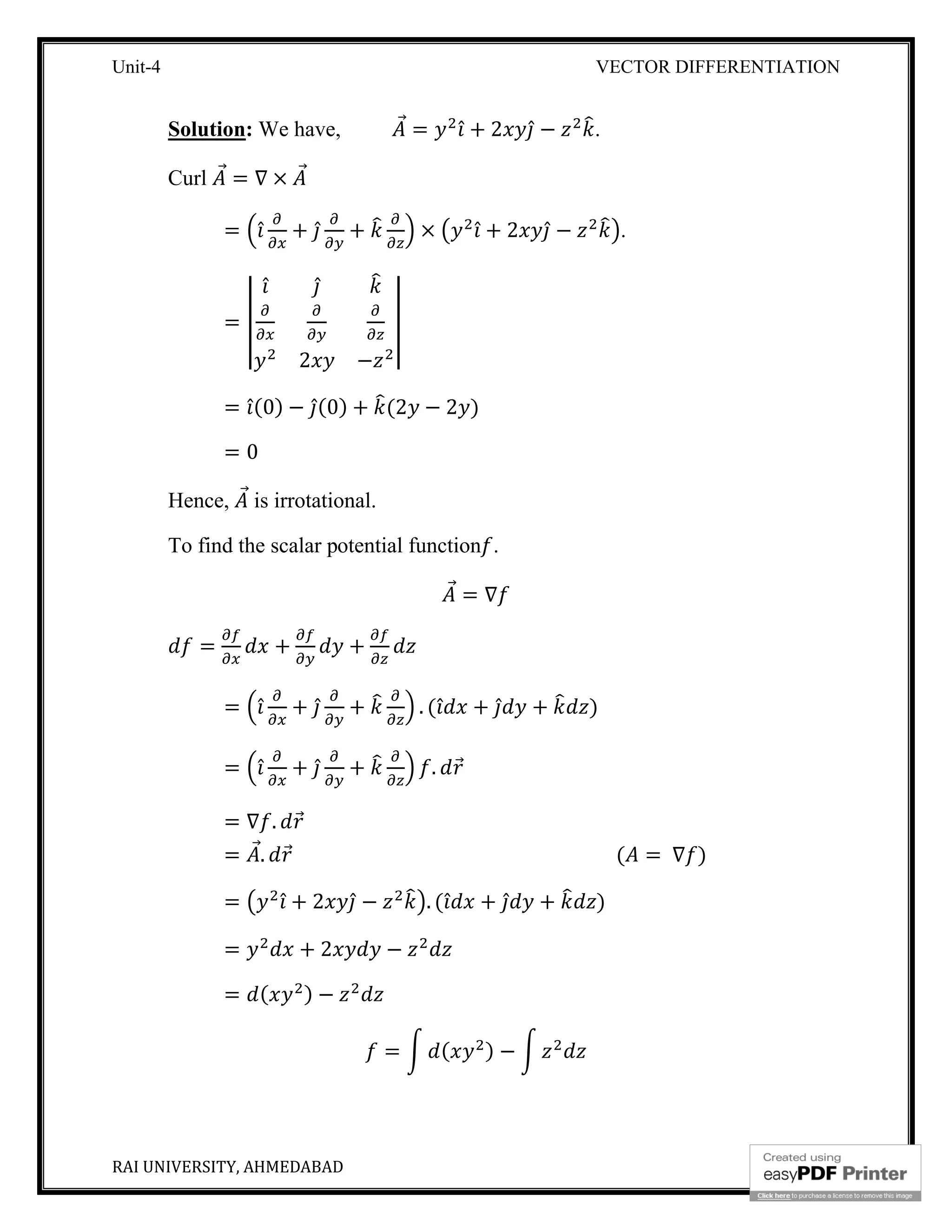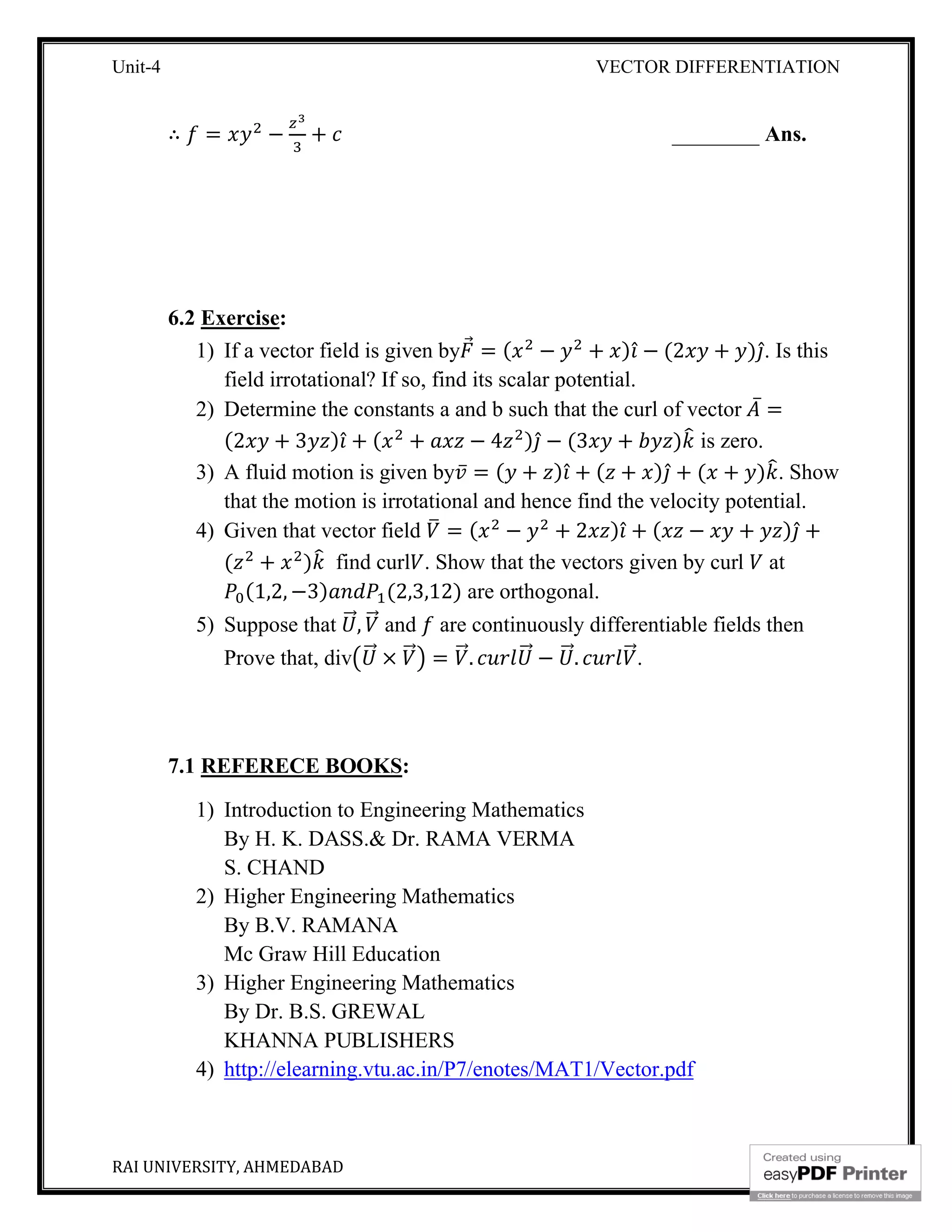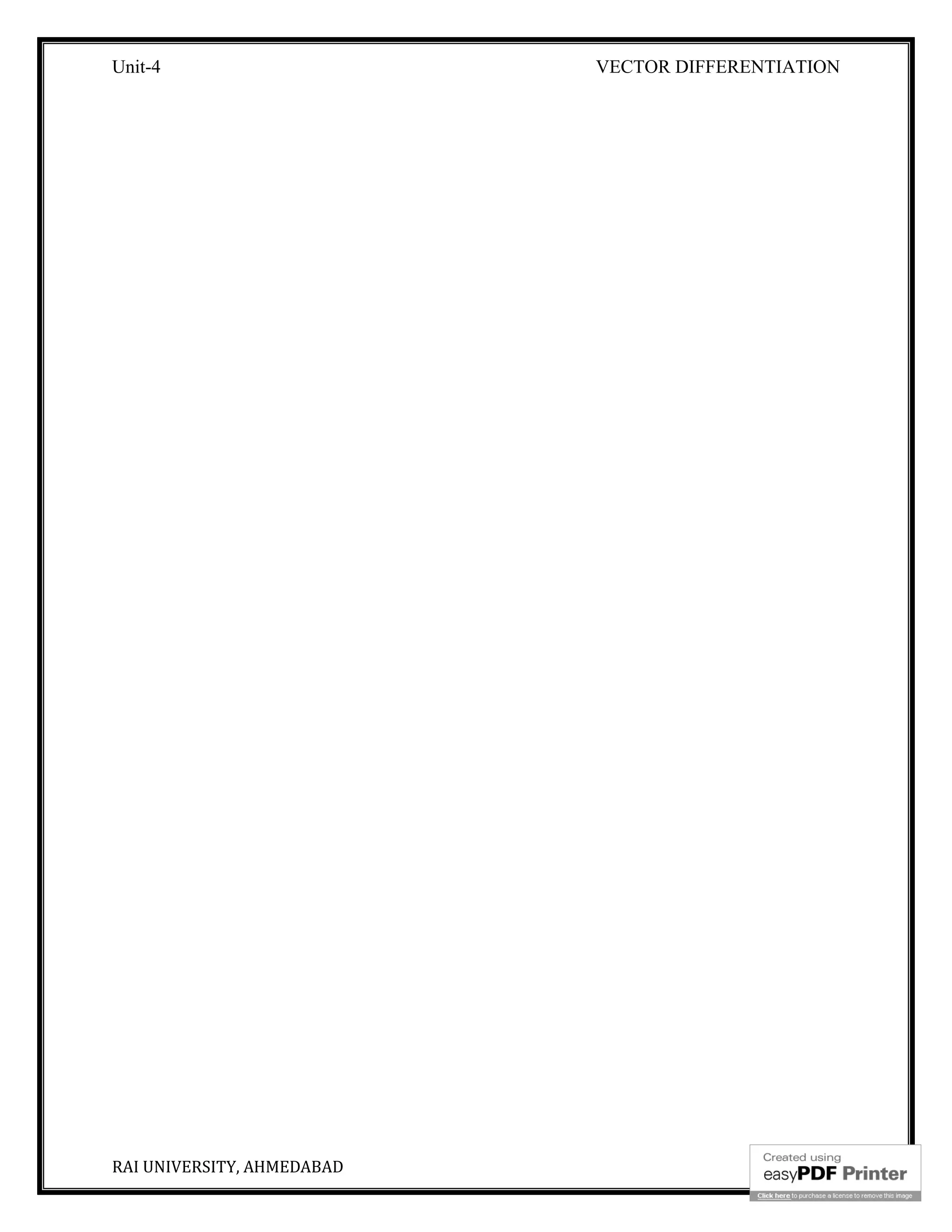This document provides an overview of vector differentiation, including gradient, divergence, curl, and related concepts. It begins with definitions of scalar and vector point functions. It then defines the vector differential operator Del and explores using it to calculate the gradient of a scalar function, directional derivatives, and normal derivatives. The document also covers divergence and curl, providing their definitions and formulas. Examples are given for calculating gradient, divergence, curl, and directional derivatives. The document concludes with exercises and references for further reading.
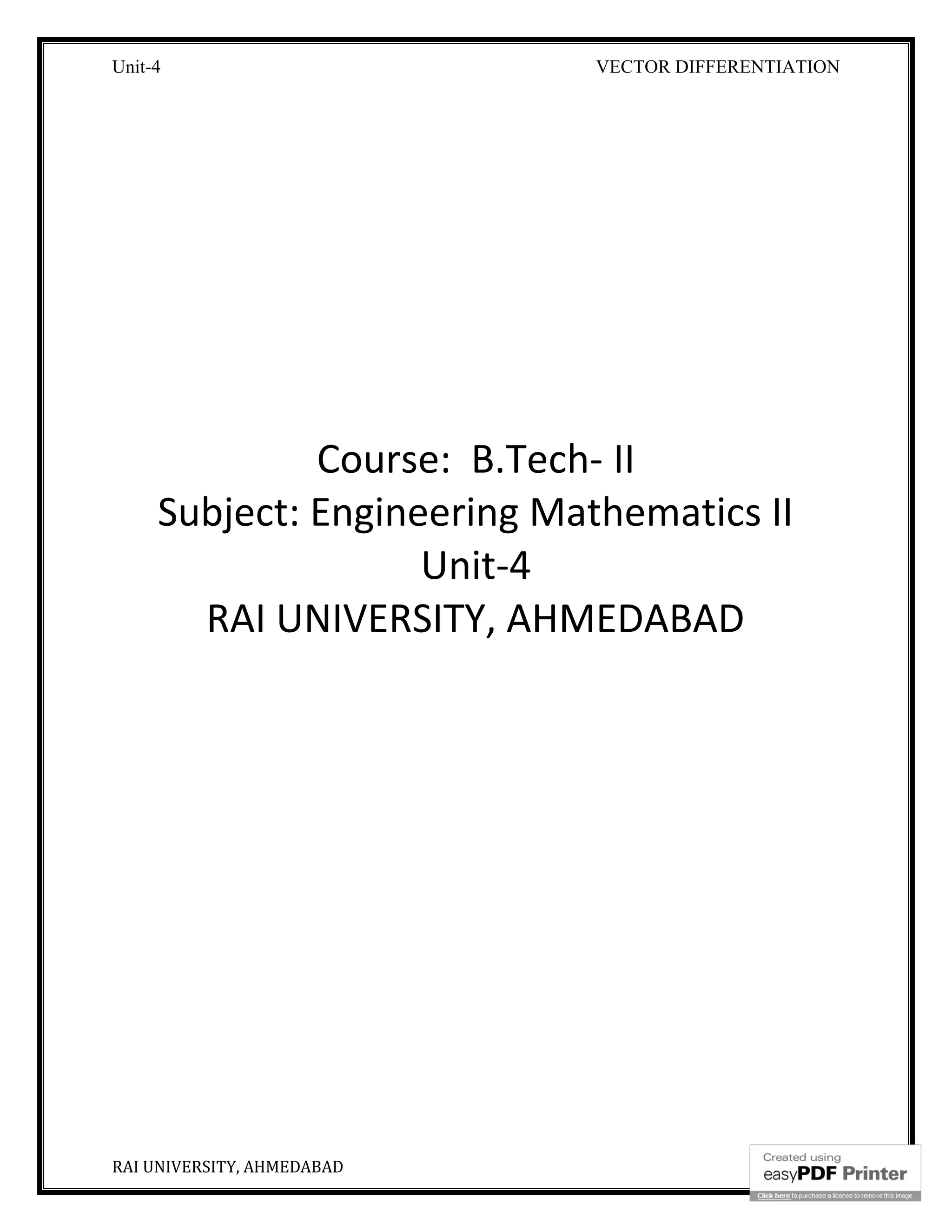
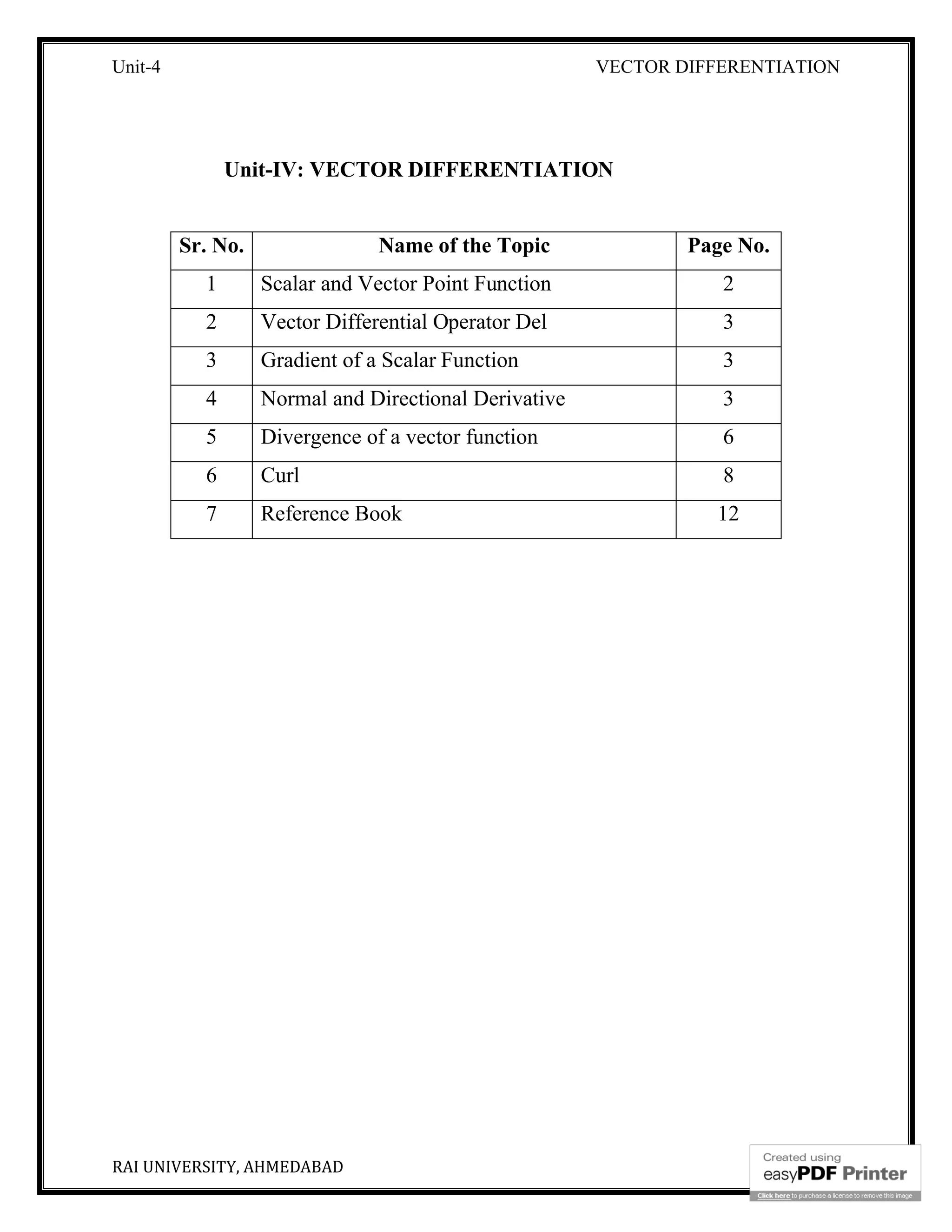
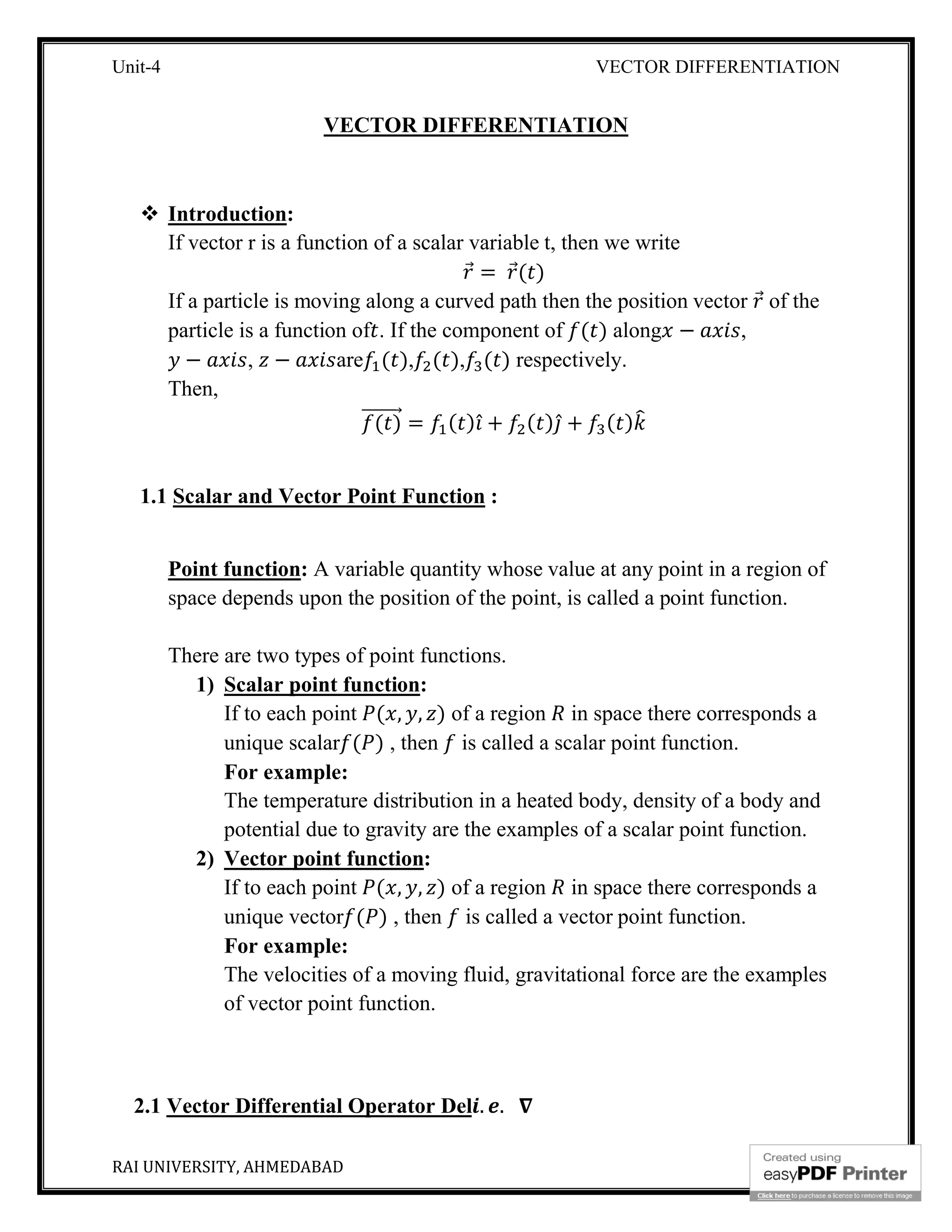
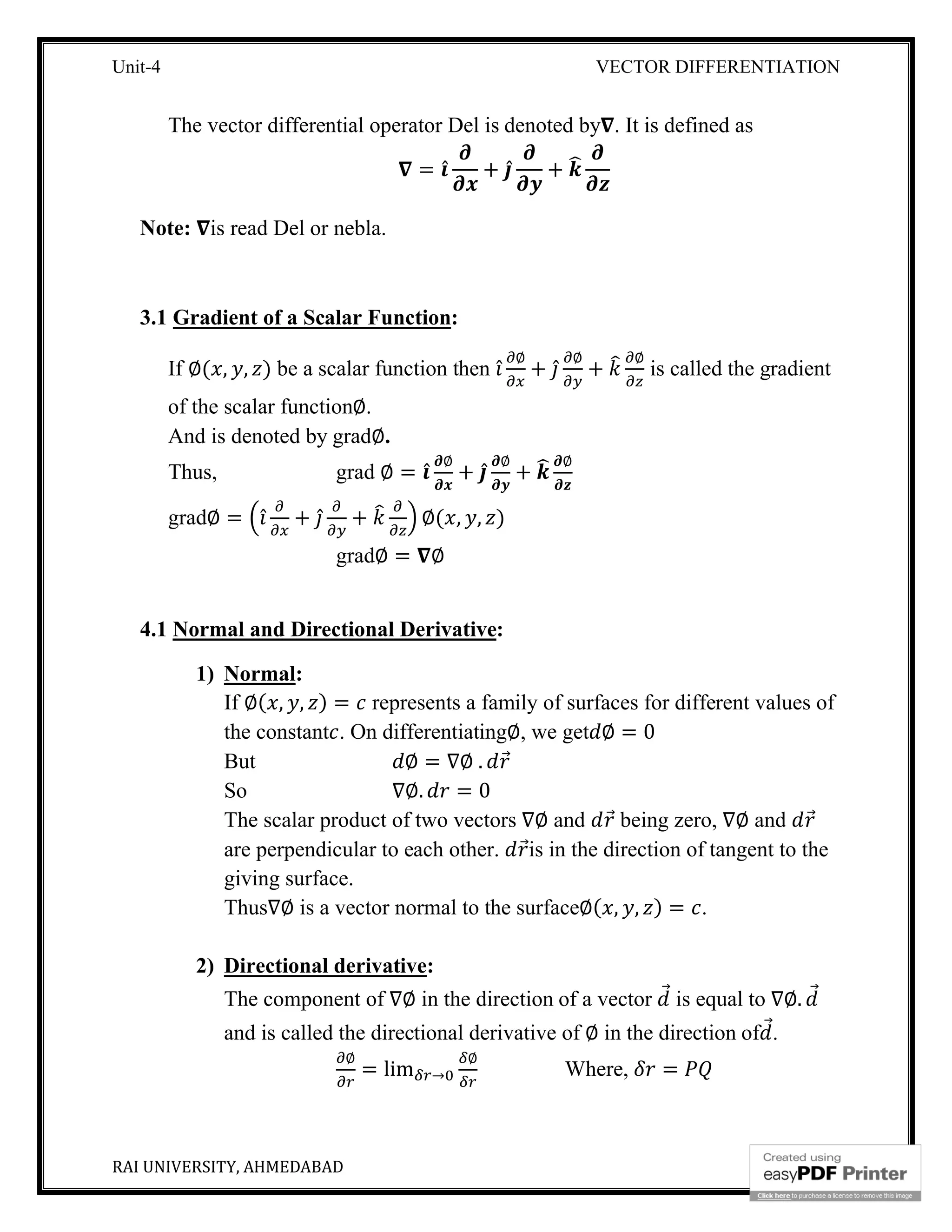
![Unit-4 VECTOR DIFFERENTIATION
RAI UNIVERSITY, AHMEDABAD 5
∅
is called the directional derivative of ∅ at in the direction of .
4.2 Examples:
Example 1: If ∅ = 3 − ; find grad ∅ at the point (1,-2, 1).
Solution:
grad∅ = ∇∅
= ̂ + ̂ + (3 − )
= ̂ (3 − ) + ̂ (3 − ) + (3 − )
= ̂(6 ) + ̂(3 − 3 ) + (−2 )
grad∅ at(1, −2,1)
= ̂(6)(1)(−2) + ̂[(3)(1) − 3(4)(1)] + (−2)(−8)(−1)
= −12 ̂ − 9 ̂ − 16
Example 2: Find the directional derivative of at the point (1, −1,1)
in the direction of the tangent to the curve
= , = sin 2 + 1, = 1 − = 0.
Solution: Let ∅ =
Direction Derivative of ∅ = ∇∅
= ̂ + ̂ + ( )
∇∅ = 2 ̂ + 2 ̂ + 2
Directional Derivative of ∅ at (1,1,-1)
= 2(1)(1) (−1) ̂ + 2(1)(1) (−1) ̂ + 2(−1)(1) (1)
= 2 ̂ + 2 ̂ − 2 _________ (1)
⃗ = ̂ + ̂ + = ̂ + ( 2 + 1) ̂ + (1 − )](https://image.slidesharecdn.com/1b8b0cdf-91b5-416f-9012-6c13a9fc82c4-160126123121/75/B-Tech-II_Unit-IV-5-2048.jpg)
![Unit-4 VECTOR DIFFERENTIATION
RAI UNIVERSITY, AHMEDABAD 6
⃗ =
⃗
= ̂ + 2 2 ̂ +
Tangent vector,
Tangent ( = 0) = ̂ + 2 (cos 0) ̂ + ( 0)
= ̂ + 2 ̂ __________ (2)
Required directional derivative along tangent = (2 ̂ + 2 ̂ − 2 )
( ̂ ̂)
√
[ (1) (2)]
=
√
=
√
_______ Ans.
Example 3: Verify ∇ × [ ( )⃗] = 0
Solution:
∇ × [ ( )⃗] = ̂ + ̂ + × [ ( )⃗]
= ̂ + ̂ + × ( )( ̂ + ̂ + )
= ̂ + ̂ + × ( ) ̂ + ( ) ̂ + ( )
=
̂ ̂
( ) ( ) ( )](https://image.slidesharecdn.com/1b8b0cdf-91b5-416f-9012-6c13a9fc82c4-160126123121/75/B-Tech-II_Unit-IV-6-2048.jpg)
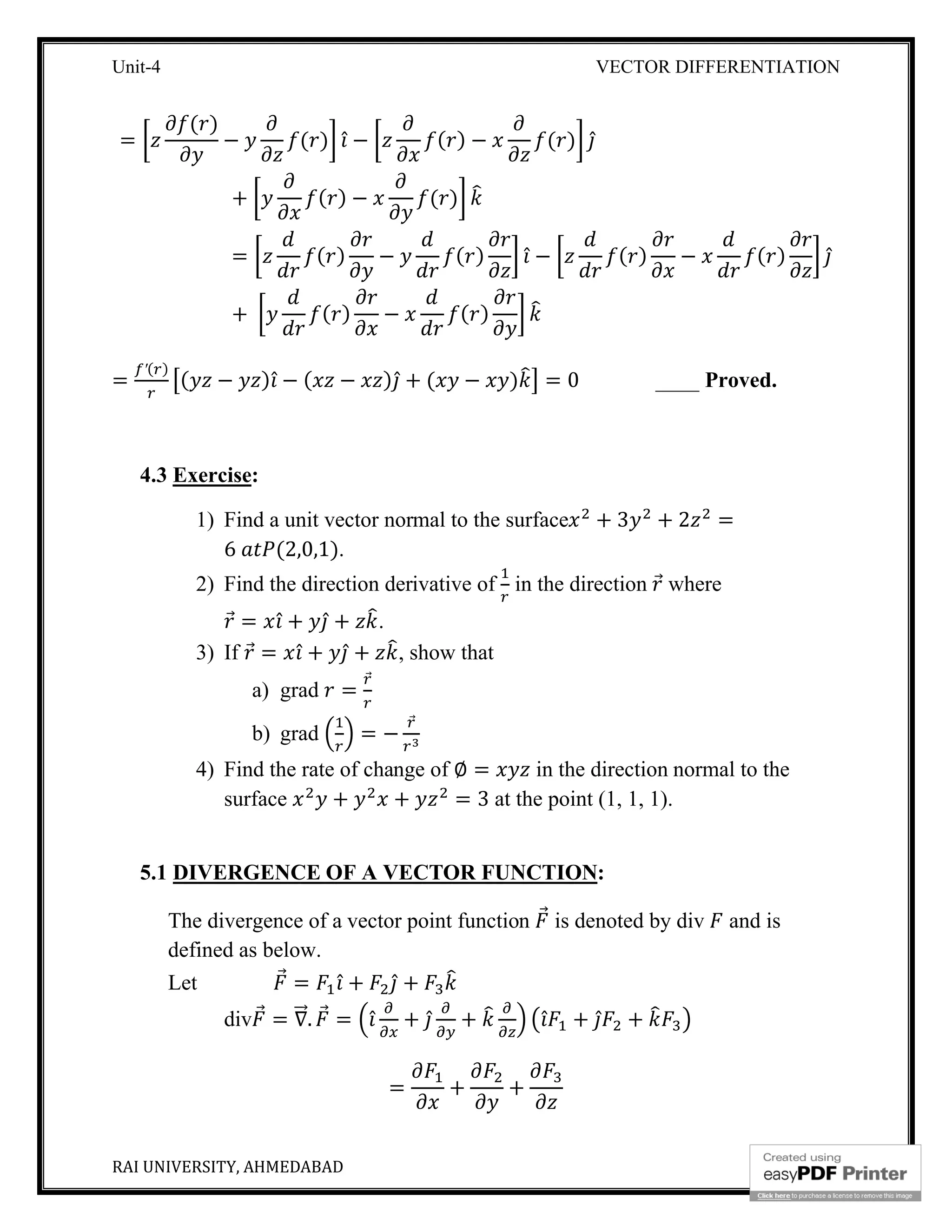
![Unit-4 VECTOR DIFFERENTIATION
RAI UNIVERSITY, AHMEDABAD 8
It is evident that div is scalar function.
Note: If the fluid is compressible, there can be no gain or loss in the volume
element. Hence
div =
Here, V is called a Solenoidal vector function. And this equation is called
equation of continuity or conservation of mass.
Example 1: If = + + , ̅ = ̂ + ̂ + , then find div ( ̅)
in terms of u.
Solution:div ( ̅) = ̂ + ̂ + ( + + ) ̂ + ̂ + =
̂ + ̂ + . ( + + ) ̂ + ( + + ) ̂ +
( + + ) ]
= ( + + ) + ( + + ) + ( + + )
= (3 + + ) + ( + 3 + ) + ( + + 3 )
= 5( + + )
= 5 ___________Ans.
Example 2: Find the directional derivative of the divergence of ̅( , , ) =
̂ + ̂ + at the point (2, 1, 2) in the direction of the outer normal to
the sphere + + = 9.
Solution: ̅( , , ) = ̂ + ̂ +
Divergence of ̅( , , ) = ∇. ̅ = ̂ + ̂ + . ̂ + ̂ +
= + 2 + 2
Directional derivative of divergence of ( + 2 + 2 )
= ̂ + ̂ + ( + 2 + 2 )](https://image.slidesharecdn.com/1b8b0cdf-91b5-416f-9012-6c13a9fc82c4-160126123121/75/B-Tech-II_Unit-IV-8-2048.jpg)
![Unit-4 VECTOR DIFFERENTIATION
RAI UNIVERSITY, AHMEDABAD 9
= 2 ̂ + (1 + 2 ) ̂ + 2 __________(i)
Directional derivative at the point (2,1,2) = 2 ̂ + 5 ̂ + 2
Normal to the sphere = ̂ + ̂ + ( + + − 9)
= 2 ̂ + 2 ̂ + 2
Normal at the point (2,1,2) = 4 ̂ + 2 ̂ + 4 __________ (ii)
Directional derivative along normal at (2,1,2) = 2 ̂ + 5 ̂ + 2 .
̂ ̂
√
[ ( ), ( )]
= (8 + 10 + 8)
= ____________ Ans.
5.2 Exercise:
1) If ̅ =
̂ ̂
, find the value of div ̅.
2) Find the directional derivative of div ( ⃗) at the point (1, 2, 2) in the
direction of the outer normal of the sphere + + = 9 for ⃗ =
̂ + ̂ + .
6.1 CURL:
The curl of a vector point function is defined as below
Curl = ∇ × = ̂ + ̂ +
= ̂ + ̂ + × ̂ + ̂ +
=
̂ ̂
= ̂ − − ̂ − + −](https://image.slidesharecdn.com/1b8b0cdf-91b5-416f-9012-6c13a9fc82c4-160126123121/75/B-Tech-II_Unit-IV-9-2048.jpg)
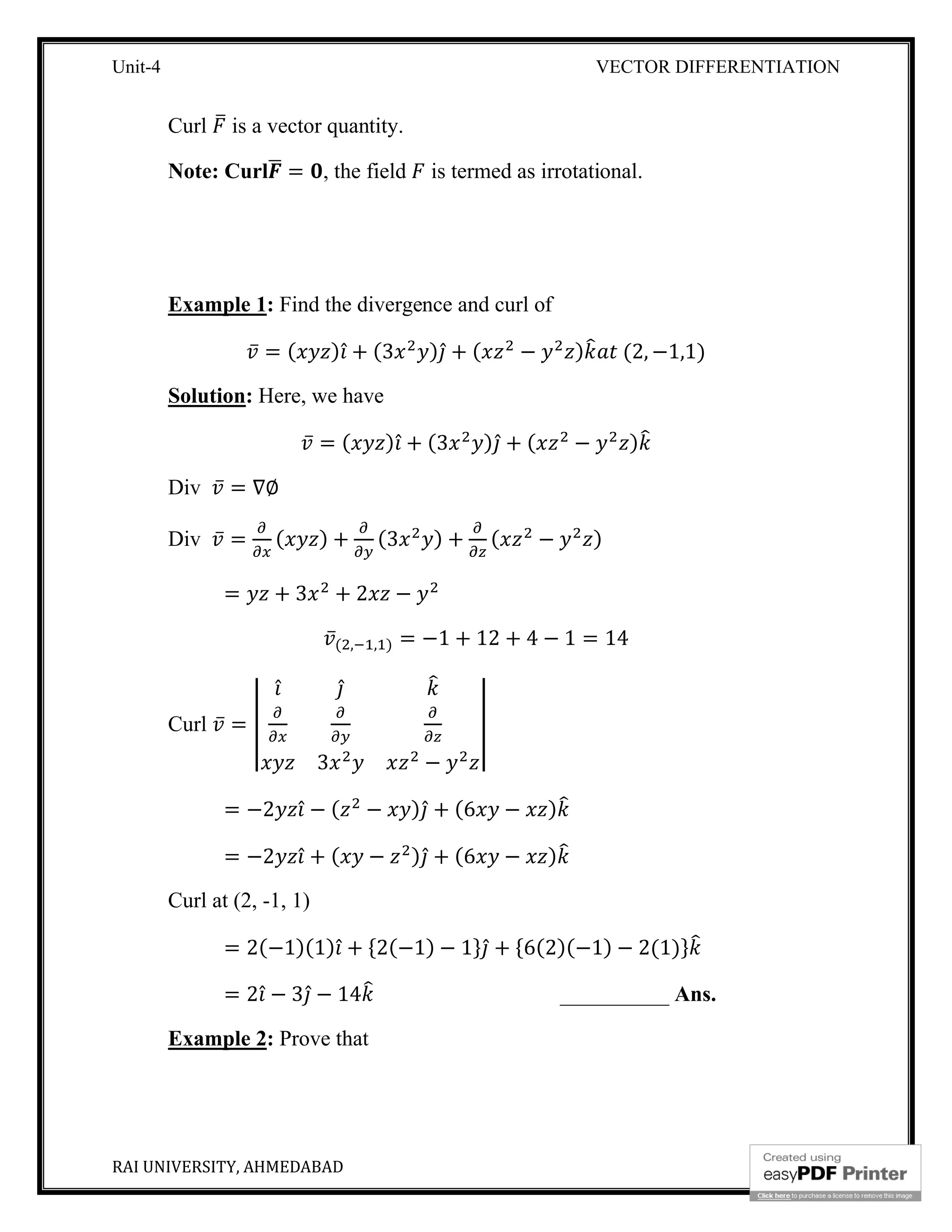
![Unit-4 VECTOR DIFFERENTIATION
RAI UNIVERSITY, AHMEDABAD 11
( − + 3 − 2 ) ̂ + (3 + 2 ) ̂ + (3 − 2 + 2 ) isboth
Solenoidal and irrotational.
Solution:
Let = ( − + 3 − 2 ) ̂ + (3 + 2 ) ̂ + (3 − 2 + 2 )
For Solenoidal, we have to prove∇. = 0.
Now,
∇. = ̂ + ̂ + . ( − + 3 − 2 ) ̂ + (3 + 2 ) ̂
+ (3 − 2 + 2 ) ]
= −2 + 2 − 2 + 2
= 0
Thus, is Solenoidal.
For irrotational, we have to prove Curl = 0
Now,
Curl =
̂ ̂
( − + 3 − 2 ) (3 + 2 ) (3 − 2 + 2 )
= (3 + 2 − 2 + 3 ) ̂ − (−2 + 3 − 3 + 2 ) ̂ + (3 + 2 − 2 − 3 )
= 0 ̂ + 0 ̂ + 0
= 0
Thus, is irrotational.
Hence, is both Solenoidal and irrotational. __________ Proved.
Example 3: Find the scalar potential (velocity potential) function for ⃗ =
̂ + 2 ̂ − .](https://image.slidesharecdn.com/1b8b0cdf-91b5-416f-9012-6c13a9fc82c4-160126123121/75/B-Tech-II_Unit-IV-11-2048.jpg)
